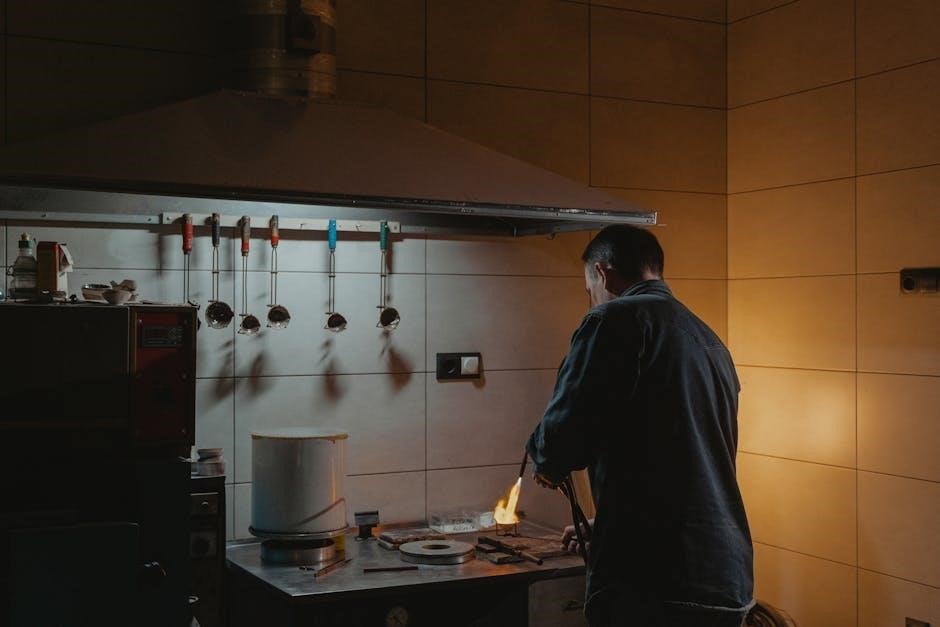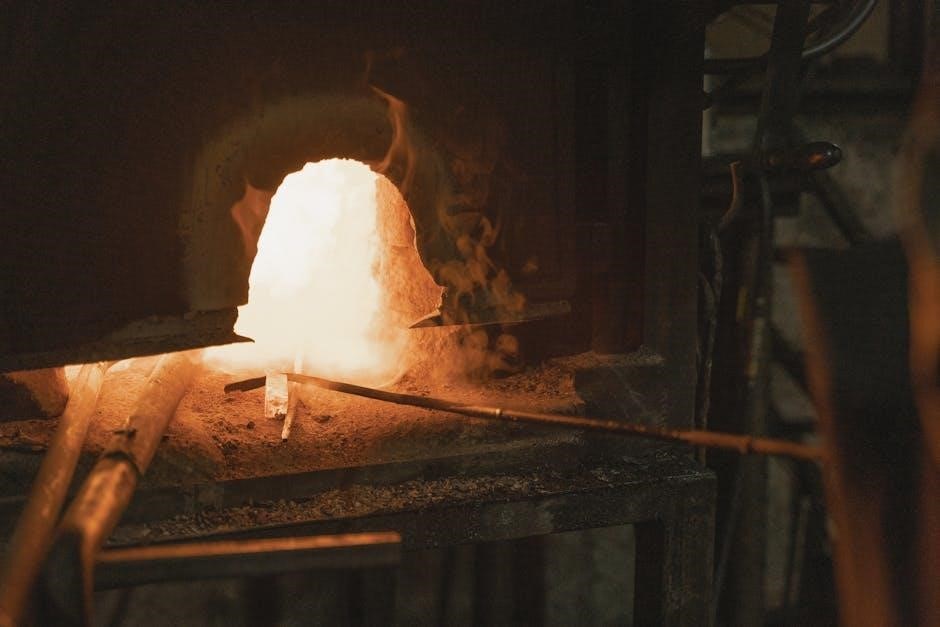The Mitsubishi Split System Heat Pump is a versatile HVAC solution designed for energy-efficient heating and cooling. It offers advanced features like inverter technology, smart sensors, and programmable timers for optimal comfort.
1.1 What is a Mitsubishi Split System Heat Pump?
A Mitsubishi Split System Heat Pump is a high-efficiency, ductless HVAC solution designed for both heating and cooling. It consists of an outdoor compressor unit and one or more indoor air-handling units connected by refrigerant lines. This system is ideal for spaces where traditional ductwork is impractical or unnecessary. The split design allows for precise temperature control in individual zones, reducing energy waste. It operates by transferring heat from one location to another, providing cooling in summer and heating in winter. The system is known for its quiet operation, energy efficiency, and advanced features like inverter technology and smart sensors. Mitsubishi’s models often include additional benefits such as anti-allergy filters, econo-cool modes, and programmable timers. This system is a popular choice for homeowners and businesses seeking a reliable, modern, and eco-friendly climate control solution.
1.2 Benefits of Using a Mitsubishi Split System Heat Pump
Using a Mitsubishi Split System Heat Pump offers numerous benefits, starting with its energy efficiency, which helps reduce utility bills. The system’s ductless design minimizes energy loss, providing consistent heating and cooling. It is also highly flexible, allowing for zoned temperature control, meaning you can heat or cool specific areas without wasting energy on unused spaces. The system is whisper-quiet, making it ideal for homes, offices, and noise-sensitive environments. Mitsubishi’s advanced inverter technology ensures precise temperature control and consistent comfort. Additionally, the system is eco-friendly, using refrigerants like R410-A, which are more environmentally friendly. Maintenance is simplified due to the system’s design, which allows for easy cleaning and access to filters. The split system also enhances indoor air quality with features like anti-allergy filters, capturing pollutants and allergens. Overall, it’s a cost-effective, efficient, and reliable solution for modern heating and cooling needs.
1.3 Key Features of the Mitsubishi Split System Heat Pump
The Mitsubishi Split System Heat Pump boasts an array of advanced features designed to enhance comfort and efficiency. Its inverter-driven compressor ensures smooth operation, adjusting output to match demand, which saves energy and reduces noise. The system offers multiple operation modes, including cooling, heating, and fan-only options, providing year-round comfort. Additionally, it features smart sensors that detect human presence, automatically adjusting settings to optimize performance. The unit includes advanced filtration systems, such as the Anti-Allergy Enzyme Filter, which improves indoor air quality by capturing allergens and bacteria. It also supports programmable timers and smart scheduling, allowing users to customize operation for convenience and energy savings. With its sleek, compact design and whisper-quiet operation, the Mitsubishi Split System Heat Pump is both aesthetically pleasing and functional, making it a top choice for modern spaces. These features collectively ensure a comfortable, efficient, and low-maintenance heating and cooling solution.
1.4 How the Mitsubishi Split System Heat Pump Works
The Mitsubishi Split System Heat Pump operates by transferring heat energy between indoor and outdoor units, utilizing refrigerant to facilitate the process. In cooling mode, the indoor unit absorbs heat from the room, transferring it to the refrigerant, which carries it outside to the condenser. In heating mode, the process reverses, extracting heat from outdoor air and releasing it indoors. The system’s inverter technology ensures efficient operation by adjusting compressor speed to match demand, reducing energy consumption and noise. Smart sensors monitor room conditions, optimizing performance and maintaining consistent temperatures. The system also employs a quiet, compact design, making it suitable for residential and commercial spaces. By efficiently managing heat transfer and operating modes, the Mitsubishi Split System Heat Pump provides reliable, energy-efficient heating and cooling year-round.

Installation Guide for Mitsubishi Split System Heat Pump
The installation process involves pre-installation checks, proper placement of indoor and outdoor units, and secure electrical connections. Ensure compliance with local regulations and manufacturer guidelines for optimal performance and safety.
2.1 Pre-Installation Checks and Requirements
Before installing a Mitsubishi Split System Heat Pump, ensure the site meets specific requirements. Verify the location for the indoor and outdoor units, ensuring proper clearance and drainage. Check electrical compatibility, including voltage and circuit capacity, to avoid power issues. Inspect the area for any obstructions that might hinder airflow or installation. Ensure all necessary tools and materials are available, such as mounting brackets, refrigerant lines, and electrical connectors. Confirm local building codes and regulations are met. It’s crucial to review the manufacturer’s manual for specific guidelines to ensure a safe and efficient installation process. Proper planning and preparation prevent potential issues and ensure optimal performance of the system. Additionally, consider factors like insulation and thermal load to maximize energy efficiency and comfort. Always follow safety precautions when handling electrical and refrigerant components.
2.2 Step-by-Step Installation Process
Begin by preparing the installation site, ensuring it is level and clear of obstructions. Mount the indoor unit on a sturdy wall or floor, following the manufacturer’s guidelines for placement. Next, install the outdoor unit in a well-ventilated area, avoiding direct sunlight and extreme weather exposure. Connect the refrigerant lines between the indoor and outdoor units, ensuring they are properly insulated and sealed. Install the drainage system to manage condensate effectively. Proceed with wiring, connecting the power supply and communication cables according to the wiring diagram provided in the manual. After all connections are secure, power on the system and perform a test run to check for leaks, proper airflow, and functionality. Finally, ensure all safety precautions are in place and verify that the system operates efficiently. Always refer to the official Mitsubishi manual for detailed instructions and safety guidelines.
2.3 Wiring Diagrams and Electrical Connections
Refer to the wiring diagrams provided in the Mitsubishi manual for precise electrical connections. Ensure the power supply matches the system’s voltage requirements, typically 230V for most models. Connect the outdoor unit’s power cable to a dedicated circuit breaker, and link the communication wires between indoor and outdoor units. The remote controller requires a separate connection to the indoor unit, enabling operation mode adjustments. Ground the system properly to prevent electrical hazards. Use appropriately sized wires and connectors to avoid heat buildup and ensure reliability. Follow local electrical codes and safety standards during installation. Double-check all connections before powering on the system to avoid malfunctions or damage. Always consult a licensed electrician if unsure about any aspect of the wiring process to guarantee compliance and safety.
2.4 Post-Installation Testing and Verification
After installation, perform a comprehensive system test to ensure proper function. Power on the unit and verify operation in cooling, heating, and fan modes. Check airflow from vents and confirm temperature changes. Use the remote control to adjust settings and ensure all functions respond correctly. Inspect the refrigerant lines for leaks and proper insulation. Test the drainage system to ensure condensate is flowing correctly. Verify that the outdoor unit operates quietly and without excessive vibration. Check for any unusual noises or leaks from indoor or outdoor units. Ensure the system achieves the desired temperature efficiently. Test the timer and scheduling features to confirm they work as intended. Finally, review the installation with the user, ensuring they understand system operation and maintenance. Consult the manual or a professional if any issues arise during testing to ensure optimal performance and safety.

Operating the Mitsubishi Split System Heat Pump
Operate the system using the remote control, selecting modes like cooling, heating, or fan-only. Adjust fan speed and airflow direction for comfort. Utilize the timer and energy-saving features for efficient operation.
3.1 Understanding the Remote Control Functions
The remote control for the Mitsubishi Split System Heat Pump is designed to provide intuitive operation. It features buttons for power, mode selection, temperature adjustment, fan speed, and airflow direction. The remote also includes advanced functions like econo cool mode and smart set for energy efficiency.
- The Power button turns the unit on/off.
- The Mode button cycles between cooling, heating, and fan-only modes.
- The Temperature buttons (+/-) adjust the set temperature.
- The Fan Speed button changes airflow intensity.
- The Airflow button directs air flow vertically or horizontally.
- Smart Set optimizes comfort by automatically adjusting settings.
Using the remote, users can customize their comfort experience and optimize energy usage. The remote’s intuitive design ensures easy operation, making it simple to control the Mitsubishi Split System Heat Pump effectively.
3.2 Operation Modes: Cooling, Heating, and Fan
The Mitsubishi Split System Heat Pump offers three primary operation modes to meet different comfort needs. Each mode is designed to optimize performance and energy efficiency for various environmental conditions.
- Cooling Mode cools the room by transferring heat from the indoor unit to the outdoor unit, ideal for summer months.
- Heating Mode warms the space by extracting heat from outdoor air and transferring it indoors, suitable for colder climates.
- Fan Mode circulates air without heating or cooling, improving air quality and reducing humidity.
These modes can be selected using the remote control, ensuring flexibility in managing indoor climate. The system seamlessly transitions between modes based on temperature settings, providing consistent comfort. The Mitsubishi Split System Heat Pump’s advanced technology ensures efficient operation across all modes, making it a reliable choice for year-round comfort.
3.3 Adjusting Fan Speed and Airflow Direction
The Mitsubishi Split System Heat Pump offers three primary operation modes to meet different comfort needs. Each mode is designed to optimize performance and energy efficiency for various environmental conditions.
- Cooling Mode cools the room by transferring heat from the indoor unit to the outdoor unit, ideal for summer months.
- Heating Mode warms the space by extracting heat from outdoor air and transferring it indoors, suitable for colder climates.
- Fan Mode circulates air without heating or cooling, improving air quality and reducing humidity.
These modes can be selected using the remote control, ensuring flexibility in managing indoor climate. The system seamlessly transitions between modes based on temperature settings, providing consistent comfort. The Mitsubishi Split System Heat Pump’s advanced technology ensures efficient operation across all modes, making it a reliable choice for year-round comfort.
3.4 Using the Timer and On/Off Scheduling
The Mitsubishi Split System Heat Pump features a convenient timer function, allowing users to set specific times for the system to start and stop operation. This enhances energy efficiency by ensuring the system runs only when needed. The remote control includes buttons for setting the timer, enabling users to program the unit to turn on or off at designated times. For example, you can set the system to start cooling or heating before you arrive home or turn off automatically when leaving.
- The timer can be set in 1-hour increments up to 24 hours in advance.
- The on/off scheduling option allows you to customize the system’s operation to your daily routine.
- Press the Timer button on the remote to access and adjust the scheduling settings.
- The remote display will show a clock icon when the timer is active.
Using the timer and on/off scheduling not only saves energy but also ensures consistent comfort levels throughout the day. Refer to the official manual for detailed instructions on programming the timer for optimal performance.

Maintenance and Care for the Mitsubishi Split System Heat Pump
Regular maintenance ensures optimal performance and longevity. Clean air filters monthly, check for blockages, and ensure proper drainage. Schedule professional maintenance annually for thorough inspection and servicing.
4.1 Regular Maintenance Tasks
Regular maintenance is essential to ensure the Mitsubishi Split System Heat Pump operates efficiently and effectively. Start by cleaning or replacing the air filters monthly, as dirty filters can reduce airflow and energy efficiency. Inspect the indoor and outdoor units for dust, dirt, or debris buildup, and clean them gently with a soft cloth or brush. Check the condensate drain line regularly to prevent blockages and ensure proper water flow. Additionally, inspect the refrigerant lines for any signs of damage or leaks. Always turn off the power before performing any maintenance tasks. For more complex checks, such as electrical connections or refrigerant levels, schedule an annual professional servicing. Regular maintenance not only extends the system’s lifespan but also maintains optimal performance and energy savings.
4.2 Cleaning the Air Filter and Indoor Unit
Cleaning the air filter and indoor unit of your Mitsubishi Split System Heat Pump is crucial for maintaining efficiency and air quality. The air filter should be cleaned every 1-2 months or more frequently in dusty environments. Turn off the power supply before cleaning. Gently remove the filter and wash it with mild soap and warm water, then allow it to dry completely before reinstalling. For the indoor unit, use a soft cloth to wipe down the exterior and vents, avoiding harsh chemicals or water. Never spray water directly into the unit, as it may damage internal components. Clean the condenser coils annually to ensure proper airflow and heat transfer. Always refer to the manual for specific cleaning instructions, and avoid touching metal parts to prevent damage or rust. Regular cleaning prevents dust buildup, reduces energy consumption, and maintains optimal performance. Ensure the unit is completely dry after cleaning to avoid mold growth.
4.3 Draining and Condensate Management
Proper drainage and condensate management are essential for the efficient operation of your Mitsubishi Split System Heat Pump. The condensate drain system collects moisture from the dehumidification process during cooling mode. Regularly inspect the drain line for blockages and ensure it is securely connected to prevent water leaks. Use a condensate pump if the unit is installed below ground level or in areas with limited drainage. Check the drain pan for debris and clean it periodically to prevent mold and mildew growth. If water accumulates around the unit, it may indicate a clogged drain line. Always refer to the manual for specific instructions on handling condensate. Proper drainage ensures system efficiency, prevents water damage, and maintains indoor air quality. Address any issues promptly to avoid system malfunctions and extend the lifespan of your heat pump. Regular maintenance will keep your Mitsubishi Split System running smoothly and efficiently year-round.
4.4 Troubleshooting Common Issues
Troubleshooting your Mitsubishi Split System Heat Pump ensures optimal performance and addresses common issues promptly. If the unit does not turn on, check the power supply, circuit breaker, and remote batteries. Ensure the thermostat is set correctly and the timer is not active. For error codes, refer to the manual or the display on the remote control for specific solutions. Water leaks often indicate a clogged condensate drain line; inspect and clean it regularly. If the unit is not cooling or heating effectively, check air filters for blockages and ensure proper airflow. Strange noises may signal loose parts or debris; turn off the unit and contact a technician. Regularly review the manual for diagnostic guidance and reset functions. Addressing these issues early prevents system damage and ensures efficient operation. Always prioritize safety and consult a professional if problems persist. Proper troubleshooting maintains your system’s reliability and performance.

Advanced Features and Settings
The Mitsubishi Split System Heat Pump offers advanced features like Smart Set Mode, Econo Cool, and anti-allergy filters for enhanced efficiency and air quality. These settings optimize performance and comfort effortlessly.
5.1 Smart Set Mode and Intelligent Operation
The Mitsubishi Split System Heat Pump features Smart Set Mode, an intelligent operation that automatically adjusts heating and cooling based on room temperature. This mode ensures optimal comfort by switching between cooling and heating when the room temperature deviates by 4°F (2°C) from the set temperature for over 15 minutes. The system’s advanced sensors continuously monitor the environment and adapt operations to maintain a stable climate. Additionally, the intelligent operation integrates with the remote controller, allowing users to preset temperatures, fan speeds, and airflow directions. This seamless integration enhances energy efficiency and reduces manual adjustments, providing a convenient and smart heating and cooling experience. The Smart Set Mode is particularly useful for maintaining consistent comfort levels without constant user intervention, making it a standout feature of the Mitsubishi system.
5.2 Econo Cool Mode for Energy Efficiency
The Mitsubishi Split System Heat Pump offers an Econo Cool Mode designed to optimize energy consumption while maintaining cooling performance. This mode automatically adjusts the set temperature by 4°F (2°C) and uses a swing operation to circulate air efficiently. By doing so, it reduces the workload on the compressor and fan, leading to lower energy usage. Econo Cool Mode is ideal for situations where consistent cooling is needed without extreme temperature fluctuations. It ensures that the system operates quietly and efficiently, making it suitable for both residential and commercial settings. Users can activate this mode via the remote controller during cooling operations, and it can be easily toggled on or off based on preference. This feature highlights Mitsubishi’s commitment to providing energy-efficient solutions that enhance comfort and reduce operational costs. The Econo Cool Mode is a practical choice for those seeking to balance performance and energy savings.
5.3 Anti-Allergy Enzyme Filter and Air Quality
The Mitsubishi Split System Heat Pump features an advanced Anti-Allergy Enzyme Filter, designed to improve indoor air quality by breaking down allergens like dust mites, pollen, and pet dander. This filter uses enzymes to decompose these particles into inert substances, reducing their impact on respiratory health. By incorporating this technology, the system not only cools or heats the air but also ensures it is cleaner and healthier to breathe. This feature is particularly beneficial for individuals with allergies or sensitive respiratory systems. The Anti-Allergy Enzyme Filter works seamlessly with the heat pump’s operation, maintaining its efficiency while enhancing air purity. Regular maintenance of the filter is recommended to sustain its effectiveness and overall system performance. This innovation underscores Mitsubishi’s focus on creating systems that promote both comfort and well-being in indoor environments.
5.4 Advanced Safety Features and Protections
The Mitsubishi Split System Heat Pump is equipped with advanced safety features to ensure reliable and secure operation. These include automatic shutdown in case of malfunction, surge protection to prevent damage from power fluctuations, and high-pressure switches that safeguard the system from excessive pressure. Additionally, the unit incorporates overheating prevention mechanisms and frost protection to maintain optimal performance in varying conditions; These features are designed to protect both the system and its users, ensuring long-term durability and safety. By integrating these protections, Mitsubishi ensures a worry-free experience while maintaining high energy efficiency and comfort standards. These safety measures are a testament to Mitsubishi’s commitment to innovation and user well-being, making the system a reliable choice for residential and commercial spaces.

Additional Resources and Support
Mitsubishi offers extensive resources, including official manuals, customer service, and online forums. Video tutorials and installation guides are also available, ensuring comprehensive support for optimal system performance and troubleshooting.

6.1 Accessing the Official Mitsubishi Manual Online
Mitsubishi provides easy access to official manuals for their split system heat pumps online. Visit the Mitsubishi Electric website or trusted platforms like ManualsLib, which hosts a wide range of Mitsubishi HVAC manuals. Users can search by specific model numbers, such as the MXZ-4C36NAHZ or MSZ-GE12NA, to find detailed installation, operation, and service guides. These manuals are available in PDF format, allowing users to download or view them directly in their browser. For authorized personnel, Mitsubishi’s BDT online customer service system offers additional resources, including technical manuals and wiring diagrams. Registration may be required for certain materials, ensuring access to the most accurate and up-to-date information. These resources are essential for installation, maintenance, and troubleshooting, providing comprehensive guidance for both professionals and homeowners.
6.2 Manufacturer Support and Customer Service
Mitsubishi Electric offers comprehensive support and customer service for their split system heat pumps. Users can contact their dedicated customer service team via phone, email, or through the official website for assistance with installation, maintenance, or troubleshooting. Mitsubishi also provides extensive online resources, including FAQs, troubleshooting guides, and video tutorials, to help users resolve common issues independently. For more complex problems, authorized service providers are available to ensure professional support. Additionally, Mitsubishi’s warranty programs offer peace of mind, covering parts and labor for registered products. The company emphasizes customer satisfaction, ensuring timely and effective solutions for any inquiries or concerns related to their heat pump systems.
6.3 Online Forums and Community Discussions
Online forums and community discussions provide valuable resources for Mitsubishi split system heat pump users. Platforms like ManualsLib and Mitsubishi Electric’s official forums offer access to troubleshooting tips, installation guides, and user experiences. These communities allow users to ask questions, share insights, and learn from others who have firsthand experience with the system. Many forums feature detailed discussions on maintenance, error codes, and optimization techniques. Additionally, expert contributors often provide guidance, helping users resolve issues and maximize their system’s performance. These online spaces foster collaboration and knowledge sharing, making them an indispensable resource for both newcomers and experienced users seeking to enhance their understanding and use of the Mitsubishi split system heat pump.
6.4 Video Tutorials and Installation Guides
Video tutorials and installation guides are essential resources for installing and maintaining the Mitsubishi split system heat pump. Official Mitsubishi Electric channels on platforms like YouTube offer step-by-step installation videos, covering topics such as wiring, mounting, and refrigerant handling. These guides are complemented by detailed PDF manuals, available on websites like ManualsLib, which provide visual diagrams and instructions. Many videos also cover advanced features, such as smart sensors and Econo Cool mode, ensuring users can fully utilize their system’s capabilities. Additionally, community-driven tutorials on forums and social media platforms share real-world installation experiences, offering practical tips and solutions to common challenges. These resources empower both professionals and DIY enthusiasts to ensure a smooth and efficient setup of the Mitsubishi split system heat pump, adhering to manufacturer guidelines and safety standards.